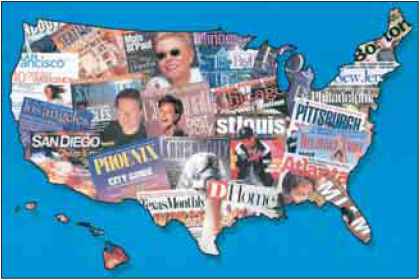High Demographic And Geographic Selectivity
women.
In addition to providing selectivity based on interests, magazines can provide advertisers with high demographic and geographic selectivity. Demographic selectivity, or the ability to reach specific demographic groups, is available in two ways. First, most magazines are, as a result of editorial content, aimed at fairly well defined demographic segments. Ladies' Home Journal, Ms., Self, and Cosmopolitan are read predominantly by women; Esquire, Playboy, and Sports Illustrated are read mostly by men. Older consumers can be reached through publications like Modern Maturity. IMC Perspective 12-1 discusses how publishers have been introducing new magazines targeted at teens in an effort to reach this elusive, but important, market segment.
A second way magazines offer demographic selectivity is through special editions. Even magazines that appeal to broader audiences, such as Reader's Digest, Time, or Newsweek, can provide a high degree of demographic selectivity through their special demographic editions. Most of the top consumer magazines publish different editions targeted at different demographic markets.
Geographic selectivity lets an advertiser focus ads in certain cities or regions. One way to achieve geographic selectivity is by using a magazine that is targeted toward a particular area. Magazines devoted to regional interests include Yankee (New England), Southern Living (South), Sunset (West), and Texas Monthly (guess where?), among many others. One of the more successful media developments of recent years has been the growth of city magazines in most major American cities. Los Angeles Magazine, Philadelphia, and Boston, to name a few, provide residents of these areas with articles concerning lifestyle, events, and the like, in these cities and their surrounding metropolitan areas (Exhibit 12-5). City and regional magazines make it possible for advertisers to focus on specific local markets that may be of interest to them. These publications also have a readership profile that appeals to marketers of upscale brands: high income, college educated, loyal, and influential in their communities.
Another way to achieve geographic selectivity in magazines is through purchasing ad space in specific geographic editions of national or regional magazines. A number of publications divide their circulation into groupings based on regions or major metropolitan areas and offer advertisers the option of concentrating their ads in these editions. For example, Newsweek breaks the United States into 11 geographic areas and
Exhibit 12-5 City magazines offer advertisers high geographic selectivity

Continue reading here: Magazines Seek the Most Elusive Readers of All Young Males
Was this article helpful?
Readers' Questions
-
aila3 months ago
- Reply
-
nancy8 months ago
- Reply
-
NANCY10 months ago
- Reply
-
Vitale1 year ago
- Reply
-
awet1 year ago
- Reply